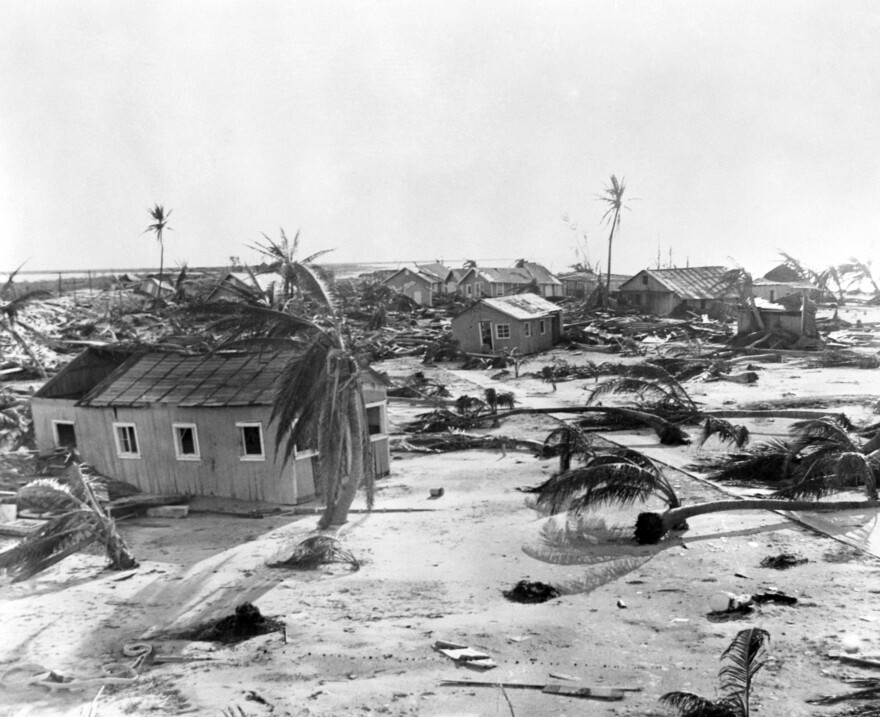Updated September 28, 2022 at 3:37 PM ET
Ian has come ashore on Florida's Gulf Coast with winds of 155 miles per hour, placing it just shy of a Category 5 storm — a ranking shared by only four hurricanes of that strength known to have made landfall in the continental U.S.
Those Category 5 storms, with maximum sustained winds of 157 miles per hour or more as measured by the Saffir-Simpson scale, all hit the U.S. on the Gulf Coast — three in Florida and one in Mississippi.

The National Hurricane Centerdescribes Category 5 storms like this: "Catastrophic damage will occur: A high percentage of framed homes will be destroyed, with total roof failure and wall collapse. Fallen trees and power poles will isolate residential areas. Power outages will last for weeks to possibly months. Most of the area will be uninhabitable for weeks or months."
Although Category 5 storms are by definition the strongest, hurricanes such as Katrina, which made landfall near New Orleans as a Category 3 in 2005, and Maria, which made landfall in Puerto Rico as a Category 4 in 2017, have often been more devastating in loss of life and financial impact.
Here, we look back at four storms that hit the U.S. as a Category 5.
1935 Labor Day Hurricane

The 1935 Labor Day Hurricane is considered the strongest storm ever recorded to make landfall in the U.S., smashing into the Florida Keys on Sept. 2, 1935, with winds of 185 mph. It killed an estimated 409 people. Although it made its way up the U.S. East Coast, "practically all losses from the hurricane were suffered in Florida, with most occurring in the Florida Keys. A swath of destruction 40 [miles] wide occurred across the Keys, from just south of Key Largo to just north of Marathon. Most manmade structures were destroyed by the hurricane's Category 5 winds, which gusted at times to over 200 mph, and the complete inundation of the islands by a 15-20 ft storm surge," according to Hurricanes: Science and Society, a website run by the University of Rhode Island's Graduate School of Oceanography.
Hurricane Camille (1969)

Hurricane Camille, the second-strongest storm on record to come ashore in the continental U.S., had sustained winds of more than 170 mph when it hit Mississippi in the late evening of Aug. 17, 1969. More than 250 people were killed, many in Virginia due to massive flooding the storm brought to that state. Camille tracked north-northwest across the Gulf of Mexico, becoming a Category 5 the day before making landfall.
The National Oceanic and Atmospheric Administration (NOAA) says: "The impacts of Hurricane Camille were felt across much of the southeast U.S., especially southeast Mississippi and southwest Alabama. Most of the inland damage was a result of fallen trees and power lines, while damage on the immediate coast was caused by both wind and storm surge. Communities saw homes and buildings damaged or destroyed, fallen trees, and flooded roads. Additionally, crops in Mississippi and Alabama took an enormous hit — peach and pecan orchards were completely destroyed, and more than 20,000 acres of corn were flattened. The majority of the crop damage — about 90% — was due to the high winds while just 10% is attributed to the intense rainfall."
Hurricane Andrew (1992)
On Aug. 24, 1992, Andrew made landfall in South Miami-Dade County with maximum sustained winds of 165 mph. Although 23 deaths were directly attributed to the storm, "Hurricane Andrew destroyed more than 50,000 homes and caused an estimated $26 billion in damage, making it at the time the most expensive natural disaster in United States history, not to be surpassed until Hurricane Katrina 13 years later," NOAA says.
Hurricane Michael (2018)

Hurricane Michael made landfall in the Florida Panhandle on Oct. 10, 2018, as a Category 5 storm, with maximum sustained winds of 161 mph. The National Weather Service says, "Wind and storm surge caused catastrophic damage, particularly in the Panama City Beach and Mexico Beach areas. Eight direct fatalities were reported: seven in Florida and one in Georgia. In addition, 43 indirect deaths were attributed to the storm."
Copyright 2022 NPR. To see more, visit https://www.npr.org.


